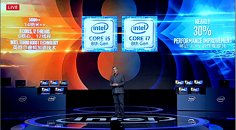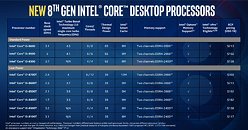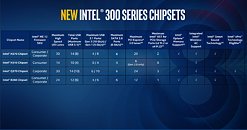- Joined
- Oct 9, 2007
- Messages
- 47,598 (7.45/day)
- Location
- Dublin, Ireland
| System Name | RBMK-1000 |
|---|---|
| Processor | AMD Ryzen 7 5700G |
| Motherboard | Gigabyte B550 AORUS Elite V2 |
| Cooling | DeepCool Gammax L240 V2 |
| Memory | 2x 16GB DDR4-3200 |
| Video Card(s) | Galax RTX 4070 Ti EX |
| Storage | Samsung 990 1TB |
| Display(s) | BenQ 1440p 60 Hz 27-inch |
| Case | Corsair Carbide 100R |
| Audio Device(s) | ASUS SupremeFX S1220A |
| Power Supply | Cooler Master MWE Gold 650W |
| Mouse | ASUS ROG Strix Impact |
| Keyboard | Gamdias Hermes E2 |
| Software | Windows 11 Pro |
Intel today expanded its 8th generation Core desktop processor family, to include xx new models across its Core i7, Core i5, and Core i3 brand extensions. The company also introduced entry-level Pentium Gold and Celeron processors. The chips are based on the 14 nm "Coffee Lake" silicon, and are compatible with socket LGA1151 motherboards based on Intel 300-series chipset. Intel has relegated dual-core to the Celeron and Pentium Gold brands. The Celeron series includes 2-core/2-thread chips with 3 MB L3 cache; while the Pentium Gold series includes 2-core/4-thread chips with 4 MB L3 cache.
The company is launching the 8th generation Celeron series with two models, the G4900 and the G4920, clocked at 3.10 GHz, and 3.20 GHz, respectively. The Pentium Gold family has three parts, the G5400, the G5500, and the G5600, clocked at 3.70 GHz, 3.80 GHz, and 3.90 GHz, respectively. The 8th generation Core i3 family of 4-core/4-thread parts receives a new member, the i3-8300. Endowed with 8 MB of L3 cache, this chip is clocked at 3.70 GHz, and sits between the i3-8100 and the i3-8350K, but lacks the unlocked multiplier of the latter.


The 8th generation Core i5 line of 6-core/6-thread chips has two new models to fill the vast gap between the i5-8400 and the i5-8600K. The new Core i5-8500 is priced just under the $200-mark, but has the psychologically better looking 3.00 GHz clocks against the i5-8400's 2.80 GHz; and 4.10 GHz Turbo Boost frequency. The Core i5-8600 (non-K) lacks the unlocked multiplier of the i5-8600K, occupies a $220 price-point, and has slightly lower clocks of 3.10 GHz, with 4.20 GHz Turbo.
Intel introduced three new chipsets to make the platform more affordable. Until now, you were restricted to the expensive Z370 Express chipset, and motherboards based on it start upwards of $139. The new chipsets introduced are the H370 Express, B360 Express, and the H310 Express. The H370 Express has a nearly identical feature-set to the Z370 Express, but lacks PEG lane segmentation, meaning you can't expect motherboards based on it to feature NVIDIA SLI support, or AMD CrossFire with x8/x8 slots. It also lacks CPU overclocking via multiplier. The B360 Express features Intel Small Business Advantage, fewer downstream PCIe lanes (only up to two M.2 slots), and fewer USB 3.1 ports. The H310 Express is entry-level, and has fewer SATA ports, and gen 2.0 general purpose PCI-Express lanes.

View at TechPowerUp Main Site
The company is launching the 8th generation Celeron series with two models, the G4900 and the G4920, clocked at 3.10 GHz, and 3.20 GHz, respectively. The Pentium Gold family has three parts, the G5400, the G5500, and the G5600, clocked at 3.70 GHz, 3.80 GHz, and 3.90 GHz, respectively. The 8th generation Core i3 family of 4-core/4-thread parts receives a new member, the i3-8300. Endowed with 8 MB of L3 cache, this chip is clocked at 3.70 GHz, and sits between the i3-8100 and the i3-8350K, but lacks the unlocked multiplier of the latter.


The 8th generation Core i5 line of 6-core/6-thread chips has two new models to fill the vast gap between the i5-8400 and the i5-8600K. The new Core i5-8500 is priced just under the $200-mark, but has the psychologically better looking 3.00 GHz clocks against the i5-8400's 2.80 GHz; and 4.10 GHz Turbo Boost frequency. The Core i5-8600 (non-K) lacks the unlocked multiplier of the i5-8600K, occupies a $220 price-point, and has slightly lower clocks of 3.10 GHz, with 4.20 GHz Turbo.
Intel introduced three new chipsets to make the platform more affordable. Until now, you were restricted to the expensive Z370 Express chipset, and motherboards based on it start upwards of $139. The new chipsets introduced are the H370 Express, B360 Express, and the H310 Express. The H370 Express has a nearly identical feature-set to the Z370 Express, but lacks PEG lane segmentation, meaning you can't expect motherboards based on it to feature NVIDIA SLI support, or AMD CrossFire with x8/x8 slots. It also lacks CPU overclocking via multiplier. The B360 Express features Intel Small Business Advantage, fewer downstream PCIe lanes (only up to two M.2 slots), and fewer USB 3.1 ports. The H310 Express is entry-level, and has fewer SATA ports, and gen 2.0 general purpose PCI-Express lanes.

View at TechPowerUp Main Site


